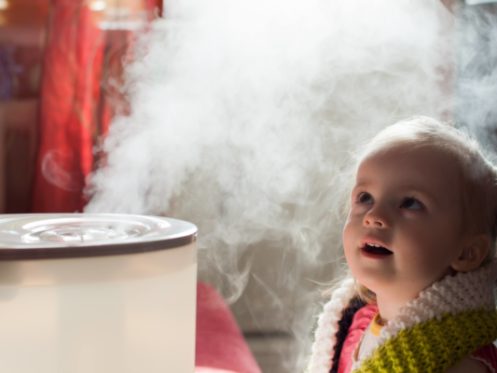Where Is the Best Place to Install a Whole-home Humidifier?

Low indoor humidity is a common problem in the winter. Cold air is always much less humid than warm air, which is why the humidity level inside your home is always lower in winter than in summer. Compounding this fact is that your heating system will also dry out the air even further every time it runs. This problem is worse for furnaces, but it can also impact heating systems that use a heat pump. Installing a whole-home humidifier is the best way to overcome issues with low indoor humidity, and here is everything you need to know about choosing the best location for these units.
Portable vs. True Whole-home Humidifiers
Before we get into where a whole-home humidifier should be installed, it is first necessary to make a distinction between the different types of units. Many manufacturers market some large units as whole-home humidifiers when the truth is that they’re really just larger, more powerful portable units. Some of these larger units can help to raise the humidity level throughout an apartment or small home, but they still aren’t technically whole-home humidifiers.
A true whole-home humidifier is permanently mounted inside of your home’s ductwork and adds moisture to the air whenever your heating system is running. This ensures that the moist air is more effectively circulated throughout every room in your home.
The larger portable units will still put out lots of warm, moist air to help keep your home from being as dry. However, these units will always affect a smaller area since they have no way to circulate all of that moist air throughout every part of the home. The only way that one of these portable units can ever affect the humidity inside the entire building is if it is located directly in front of the return register where air is drawn into your HVAC system. Even then, the unit still won’t be nearly as effective as using a true whole-home humidifier.
Understanding the Options for Installing a Whole-home Humidifier
Installing a whole-home humidifier involves cutting a hole in the existing ductwork and then mounting the unit inside. There are only two possible locations where the unit can go — either in the return air duct that feeds into the furnace or the supply duct that carries hot air out of the furnace. Either way, the main part of the unit is mounted outside of the duct, but the vent where the moisture flows out of the unit is inside the duct.
If the humidifier is installed in the return duct, it will humidify the cold air in the duct before it enters the furnace. When the humidifier is in the supply duct, it will add moisture to the hot air coming out of the furnace. There is generally no difference between the two locations in terms of the effectiveness of the unit. That being said, it is always best to install the humidifier in the return duct if possible.
If the unit is mounted inside of the supply duct, it will typically sit just above the furnace. This isn’t an ideal location since there is always a chance that the humidifier could leak water. If the humidifier or the drain line develops a leak, the water will drip into the furnace and can seriously damage the electrical components and wiring or possibly ruin the furnace altogether.
Another reason that it is better to install the humidifier in the return duct is that it typically shortens the length of the drain line. If your home also has central air conditioning, there is most likely a floor drain located near the furnace and air handler where the condensate drain line from the AC empties out. The closer the humidifier is to the drain and the shorter the drain line is, the less chance there is of the line getting clogged or stagnant water building up inside the line.
If the return duct isn’t accessible or there is some either reason that prevents the unit from being installed in this duct, you can still choose to have the humidifier mounted in the supply duct. However, you will need to be much more diligent about monitoring the unit and ensuring that it isn’t leaking and the water is draining out of the line properly.
The most common reason that the unit would need to be installed in the supply duct is that there isn’t sufficient space to run a water line to the unit. Whole-home humidifiers have to be directly connected to your plumbing system as this is the only way to provide the water they need to function. As a result, the location and layout of both your plumbing and heating system will sometimes dictate where the humidifier can and can’t be installed.
Another possibility is that there isn’t enough space within the duct to mount the humidistat. Just as a thermostat measures temperature and signals your HVAC system to turn on and off, a humidistat measures humidity level and signals the humidifier to turn on and off. The humidistat should typically be located inside the return duct approximately 6 inches above the humidifier. It can also be mounted directly on the side of the return duct, but this often prevents it from getting as accurate of a reading. If there isn’t sufficient space for the humidistat, you are usually best off having it mounted on the wall near your thermostat instead.
How Does a Whole-home Humidifier Work?
All humidifiers work by using heat to transform liquid water into vapor, and this water vapor is then pumped out to raise the humidity level of the air inside the building. Whole-home humidifiers will generally only ever run when your furnace or heat pump is on and currently heating. Depending on its settings and the current indoor humidity level, the unit may not ever run the whole time the heating system is on.
If the HVAC blower isn’t running, all of the moisture produced by the thermostat will remain inside the duct since the fan isn’t circulating air through the system. If you find that the air inside your home is still extremely dry after your heating system shuts off, you do have the option to continue to run the humidifier manually. This can be done by changing the settings on the thermostat and switching the fan setting on the thermostat to “On” instead of “Auto” so that the fan runs constantly.
The only issue with doing this is that the fan will begin to circulate cold air eventually if your furnace or heat pump isn’t running. Still, this typically isn’t nearly as big of a concern in warmer climates like Houston as it is in colder northern locations.
Whenever the humidifier is running, water is constantly flowing into the unit and steam is coming out. Inside the humidifier are an electric heating coil and heat exchanger. Electricity flows through the coil to create heat, and this raises the temperature of the heat exchanger. The exchanger transfers heat to the water, raising its temperature and causing much of it to evaporate into vapor. The vapor is pumped out into the duct, and the blower fan circulates the vapor and heated air through the ductwork and out of all of your supply vents.
Houston’s HVAC and Indoor Air Quality Experts
At The Lee Thompson Co., we install, service, and repair a range of indoor air quality equipment including humidifiers, dehumidifiers, air filtration systems, air purifiers, and UV HVAC lights. We also install and service furnaces, boilers, heat pumps, air conditioners, and ductless mini-splits, and we work on both residential and commercial HVAC systems for customers throughout the Houston area. Give us a call today if you have any questions or need any HVAC or air quality service.

